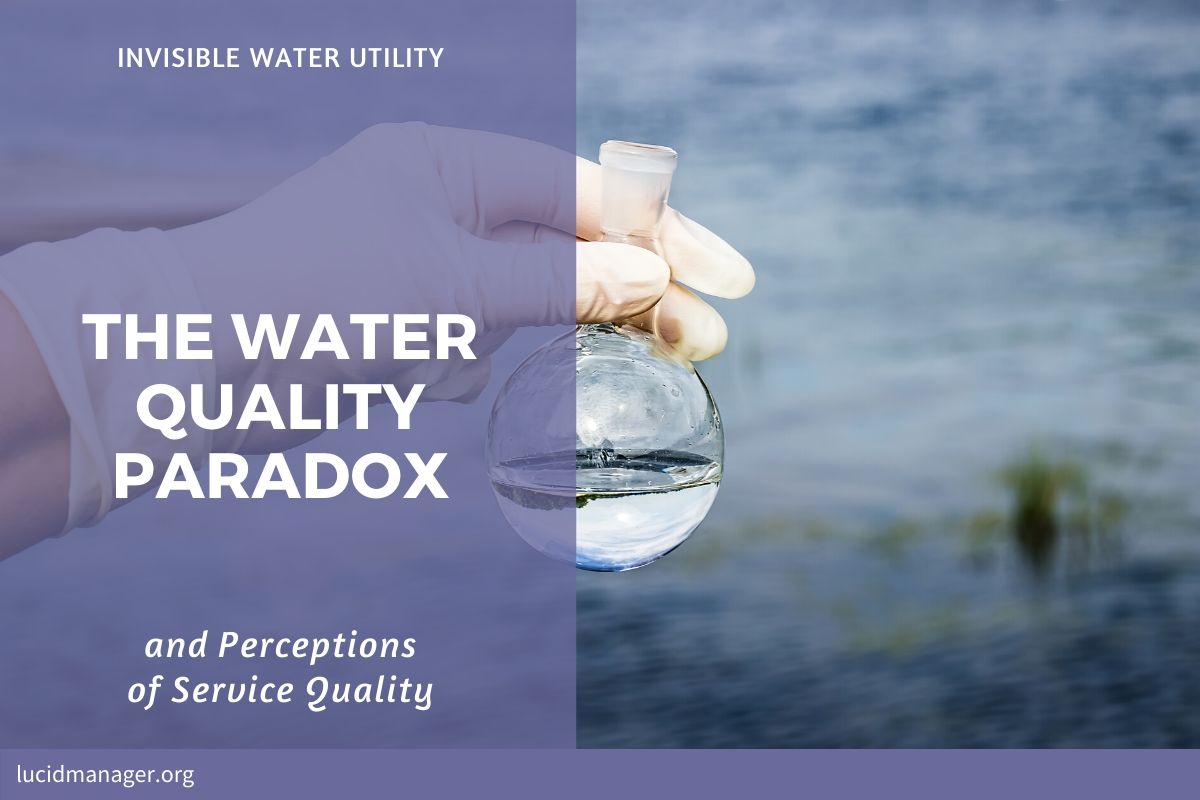
The Water Quality Paradox and Perceptions of Service Quality

Peter Prevos |
916 words | 5 minutes
Share this content
Every day, thousands of engineers around the world work hard every day to provide potable water quality to their customers thereby keeping cities liveable and preventing disease. They do this work invisible to most people as customers have very simple, but very high expectations of service. Nevertheless, regularly often complain. This article discusses the water quality paradox at the heart of many of these complaints.
Although in well-managed systems, the chances that somebody does not receive an excellent service through their tap are extremely low, consumer perception of these services is often not as good as engineers would hope for. The reason for this is because there is a paradox in the provision of water services. Operators of drinking water systems need to comply with local regulatory requirements. Meeting these requirements can, however, lead to a reduction in service quality. For example, adding chlorine is essential to ensure public health in that it destroys micro-organisms. In some communities, however, chlorine is perceived as an unwanted chemical, leading to a reduction in service quality.
The water quality paradox is one of the main issues faced by water utilities. A case in point is the resistance against adding fluoride to water, such as explained in this video.
Water Quality Paradox
The water quality paradox implies that we can not influence the total experience of the service enjoyed by customers because there are always aspects outside the control of the service provider. What at first seems like a paradox is, however, not paradoxical. Water services are like internet services, as they are provided at the customer's premises and they use their equipment to consume the service. The cause of the paradox in water quality is the fact that we cannot control all variables that make up the customer experience. To the customer, however, this is not important, and any service failure will reflect negatively on the service provider.
Providing safe water is the most important task of engineers in a water utility. Operators of drinking water systems comply with local regulations to meet this objective. Meeting these requirements can, however, lead to a reduction in the perception of quality by the consumer. For example, adding chlorine is essential to ensure public health in that it destroys micro-organisms, but in some communities chlorine is perceived as an unwanted chemical.
Providing safe water is a necessary condition. but not a sufficient condition to achieve customer satisfaction.
Safe Water Versus Good Water
A search on "tap water" on Twitter shows that taste is the main concern. The taste of water is, however, influenced not only by the chemical and biological quality of the water itself but also by other circumstances, such as the cup people drink it from. The researchers found that the firmness of a cup from which you drink water can influence our judgments of the taste of water.
Service quality is the overall assessment of quality by the customer. In reticulated water, it has two perspectives: that of the customer and that of the service provider. The customer extrinsically assesses the experienced quality attributes concerning what they perceive. From the service provider's perspective, quality resides intrinsically within the service itself. The service provider is interested in providing safe water by meeting the relevant regulations—the customer is interested in good water through a positive consumption experience.
The intrinsic perspective of the water engineer is predictable and rational. Water safety expresses itself in e-Coli counts, electrical conductivity and other scientific parameters. However, the extrinsic perspective of the consumer's individual perception is non-rational. This non-rationality does not imply that consumers are irrational. A non-rational perspective is one that includes emotional assessments that numbers cannot describe. How users of water systems view their service (good water) only partially overlaps with how engineers and scientists see the service (safe water). Customers are thus interested in good water and take safe water for granted. This aspect of water quality is for marketers to assess.
Experience and Credence Qualities
In marketing jargon, good water is determined by experience qualities while safe water is determined by the credence qualities of water. Experience qualities are attributes such as taste, that can only be discerned after purchase or during consumption, and credence qualities are attributes which consumers find impossible to evaluate because they do not have the knowledge or skill to do so and because many aspects of safe water are not immediately perceivable. This idea implies that as customers cannot experience the safety aspects of water directly, trust is one of the most important parameters in the provision of water services.

To provide a complete picture of service quality in water, it is important not to focus only on the intrinsic scientific aspects of service provision. A complete measurement system will include the non-rational dimensions of human perception. Scientists and engineers responsible for water safety need to work together with marketers to provide a complete understanding of water quality.
If you like to find out more about using marketing theory to manage the experience of water utility customers, then please consider reading Customer Experience Management for Water Utilities by Peter Prevos.

Customer Experience Management for Water Utilities: Marketing Urban Water Supply
Practical framework for water utilities to become more focused on their customers following Service-Dominant Logic.
@InvisibleH2O @lsimas17: @InvisibleH2O Great article. As a Portuguese tap water quality regulator, I am going to take it into account
— Luís Simas (@lsimas17) July 17, 2013
Share this content


